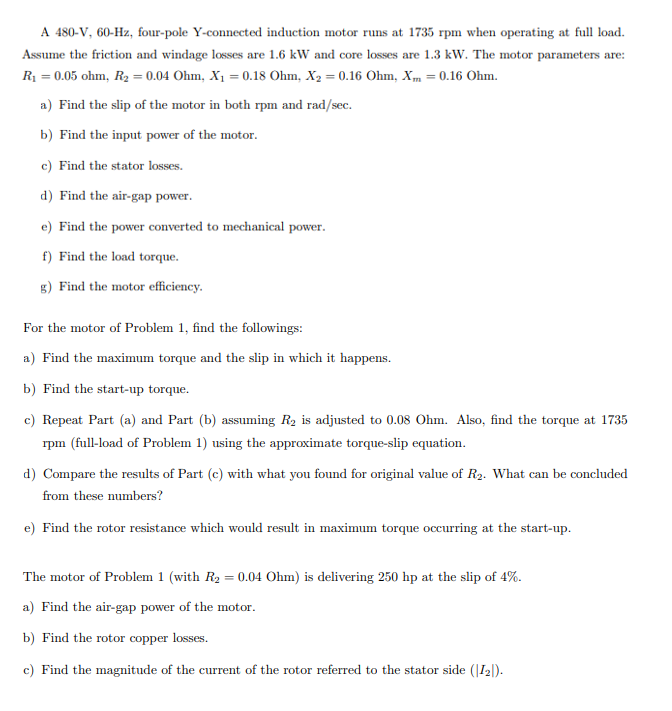A 480-V, 60-Hz, four-pole Y-connected induction motor runs at 1735 rpm when operating at full load. Assume the friction and windage losses are 1.6 kW and core losses are 1.3 kW. The motor parameters are: R₁ = 0.05 ohm, R2 = 0.04 Ohm, X₁ = 0.18 Ohm, X2 = 0.16 Ohm, X = 0.16 Ohm. a) Find the slip of the motor in both rpm and rad/sec. b) Find the input power of the motor. c) Find the stator losses. d) Find the air-gap power. e) Find the power converted to mechanical power. f) Find the load torque. g) Find the motor efficiency. For the motor of Problem 1, find the followings: a) Find the maximum torque and the slip in which it happens. b) Find the start-up torque. c) Repeat Part (a) and Part (b) assuming R2 is adjusted to 0.08 Ohm. Also, find the torque at 1735 rpm (full-load of Problem 1) using the approximate torque-slip equation. d) Compare the results of Part (c) with what you found for original value of R2. What can be concluded from these numbers? e) Find the rotor resistance which would result in maximum torque occurring at the start-up. The motor of Problem 1 (with R2 = 0.04 Ohm) is delivering 250 hp at the slip of 4%. a) Find the air-gap power of the motor. b) Find the rotor copper losses. c) Find the magnitude of the current of the rotor referred to the stator side (|12|).
A 480-V, 60-Hz, four-pole Y-connected induction motor runs at 1735 rpm when operating at full load. Assume the friction and windage losses are 1.6 kW and core losses are 1.3 kW. The motor parameters are: R₁ = 0.05 ohm, R2 = 0.04 Ohm, X₁ = 0.18 Ohm, X2 = 0.16 Ohm, X = 0.16 Ohm. a) Find the slip of the motor in both rpm and rad/sec. b) Find the input power of the motor. c) Find the stator losses. d) Find the air-gap power. e) Find the power converted to mechanical power. f) Find the load torque. g) Find the motor efficiency. For the motor of Problem 1, find the followings: a) Find the maximum torque and the slip in which it happens. b) Find the start-up torque. c) Repeat Part (a) and Part (b) assuming R2 is adjusted to 0.08 Ohm. Also, find the torque at 1735 rpm (full-load of Problem 1) using the approximate torque-slip equation. d) Compare the results of Part (c) with what you found for original value of R2. What can be concluded from these numbers? e) Find the rotor resistance which would result in maximum torque occurring at the start-up. The motor of Problem 1 (with R2 = 0.04 Ohm) is delivering 250 hp at the slip of 4%. a) Find the air-gap power of the motor. b) Find the rotor copper losses. c) Find the magnitude of the current of the rotor referred to the stator side (|12|).
Chapter33: Four-speed, Two-winding (consequent Pole) Motor Controllers
Section: Chapter Questions
Problem 7SQ: Why are different motor connections shown for what appears to be the same motor in the various...
Related questions
Question

Transcribed Image Text:A 480-V, 60-Hz, four-pole Y-connected induction motor runs at 1735 rpm when operating at full load.
Assume the friction and windage losses are 1.6 kW and core losses are 1.3 kW. The motor parameters are:
R₁ = 0.05 ohm, R2 = 0.04 Ohm, X₁ = 0.18 Ohm, X2 = 0.16 Ohm, X = 0.16 Ohm.
a) Find the slip of the motor in both rpm and rad/sec.
b) Find the input power of the motor.
c) Find the stator losses.
d) Find the air-gap power.
e) Find the power converted to mechanical power.
f) Find the load torque.
g) Find the motor efficiency.
For the motor of Problem 1, find the followings:
a) Find the maximum torque and the slip in which it happens.
b) Find the start-up torque.
c) Repeat Part (a) and Part (b) assuming R2 is adjusted to 0.08 Ohm. Also, find the torque at 1735
rpm (full-load of Problem 1) using the approximate torque-slip equation.
d) Compare the results of Part (c) with what you found for original value of R2. What can be concluded
from these numbers?
e) Find the rotor resistance which would result in maximum torque occurring at the start-up.
The motor of Problem 1 (with R2 = 0.04 Ohm) is delivering 250 hp at the slip of 4%.
a) Find the air-gap power of the motor.
b) Find the rotor copper losses.
c) Find the magnitude of the current of the rotor referred to the stator side (|12|).
AI-Generated Solution
Unlock instant AI solutions
Tap the button
to generate a solution
Recommended textbooks for you


Electricity for Refrigeration, Heating, and Air C…
Mechanical Engineering
ISBN:
9781337399128
Author:
Russell E. Smith
Publisher:
Cengage Learning

Delmar's Standard Textbook Of Electricity
Electrical Engineering
ISBN:
9781337900348
Author:
Stephen L. Herman
Publisher:
Cengage Learning


Electricity for Refrigeration, Heating, and Air C…
Mechanical Engineering
ISBN:
9781337399128
Author:
Russell E. Smith
Publisher:
Cengage Learning

Delmar's Standard Textbook Of Electricity
Electrical Engineering
ISBN:
9781337900348
Author:
Stephen L. Herman
Publisher:
Cengage Learning